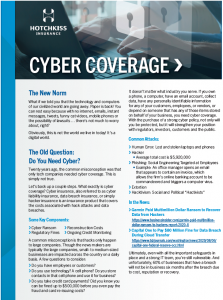Cyber Insurance: Do You Really Need it?
It’s a digital world out there, and we know cyber crime is a real threat, but what are the implications for your specific business?

If you’re considering cyber insurance, also called “cyber risk insurance” or “cyber liability insurance,” it’s easy to get overwhelmed with questions: Is my organization too small to need this coverage? Are some industries impacted more than others? Is this an expensive addition to my insurance plan?
We’re digging in to some common concerns about this important coverage.
The Old Question: Do You Need Cyber?
Twenty years ago, the common misconception was that only tech companies needed cyber coverage. This is simply not true.
Let’s back up a couple steps. What exactly is cyber coverage? Cyber insurance, also referred to as cyber liability insurance, data breach insurance, or simply hacker insurance, is an insurance product that covers the costs associated with hack attacks and data breaches.
Some Key Components:
- Cyber Ransom
- Reconstruction Costs
- Regulatory Fines
- Ongoing Credit Monitoring
A common misconception is that hacks only happen to large companies. Though the news makers are typically the large companies, small- to medium-sized businesses are impacted across the country on a daily basis.
A few questions to consider:
- Do you have employees or customers?
- Do you use technology? A cell phone? Do you store contacts in that cell phone and use it for business?
- Do you take credit card payments? Did you know you can be fined up to $500,000 before you even pay the fraud and card re-issuing costs?
It doesn’t matter what industry you serve. If you own a phone, a computer, have an email account, collect data, have any personally identifiable information for any of your customers, employees, or vendors, or depend on someone that has any of those items stored on behalf of your business, you need cyber coverage. With the purchase of a strong cyber policy, not only will you be protected, but it will strengthen your position with regulators, investors, customers and the public.
Common Attacks:
- Human Error: Lost and stolen laptops and phones
- Hacker
- Average total cost is $5,920,000
- Phishing: Social Engineering Targeted at Employees
- Example: An office manager opens an email that appears to contain an invoice, which allows the firm’s online banking account to be commandeered and triggers a computer virus.
- Extortion
- Hacktivism: Social and Political “Hactivists”
In the News:
- Garmin Paid Multimillion Dollar Ransom to Recover Data from Hackers
- Capital One to Pay $80 Million Fine for Data Breach During Cloud Transfer
Ultimately, even with all the important safeguards in place and a strong IT team, you’re still vulnerable. And unfortunately, 60% of businesses that have a breach will not be in business six months after the breach due to cost, reputation or recovery.
The Question Now: Why Don’t You Have It?
With virtual interactions and cyber attacks on the rise, this coverage is integral to protecting your assets. Even with a strong strategy with hardware, software and cryptographic methodologies, it’s nearly impossible to achieve perfect cyber security protection; but that’s where this coverage comes into play.
At Hotchkiss Insurance, we simplify the process to protect clients with a cyber policy that complements their cyber protection strategy. For us it is not only about writing insurance, we pride ourselves in providing our clients with comprehensive enterprise risk management and a seamless client experience.
Because this is a complex risk, many clients are surprised by how affordable this coverage can be. We keep the pricing for these policies simple, as it ultimately depends on factors such as the number of identity records you keep, and the number of transactions you have in any given year.
It’s time to make the call and gain a trusted partner to vigilantly protect your assets and keep your business from becoming a statistic.